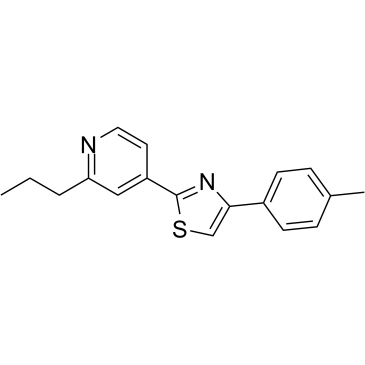Fatostatin (Synonyms: 125B11) |
| Catalog No.GC36031 |
Fatostatina (125B11), un inhibidor especÍfico de la activaciÓn de SREBP, afecta la activaciÓn de SREBP-1 y SREBP-2. La fatostatina se une a SCAP (proteÍna activadora de escisiÓn de SREBP) e inhibe la translocaciÓn de SREBP en ER-Golgi. La fatostatina disminuye la transcripciÓn de genes lipogénicos en las células. La fatostatina posee propiedades antitumorales y reduce la hiperglucemia en ratones ob/ob.
Products are for research use only. Not for human use. We do not sell to patients.

Cas No.: 125256-00-0
Sample solution is provided at 25 µL, 10mM.
Fatostatin (125B11), a specific inhibitor of SREBP activation, impairs the activation of SREBP-1 and SREBP-2. Fatostatin binds to SCAP (SREBP cleavage-activating protein), and inhibits the ER-Golgi translocation of SREBPs. Fatostatin decreases the transcription of lipogenic genes in cells. Fatostatin possesses antitumor properties, and lowers hyperglycemia in ob/ob mice[1][2].
Fatostatin (125B11) (0.1-1 μM; 3 days) inhibits the androgen-independent prostate cancer cell proliferation (IC50=0.1 μM) in an independent of the known IGF1-signaling pathway. Fatostatin inhibits insulin-induced adipogenesis of 3T3-L1 cells[1].Fatostatin directly binds SCAP and blocks its ER-to-Golgi transport with IC50 of 2.5 and 10 μM in mammalian cells.
Fatostatin (125B11) (30 mg/kg; 150 mL; i.p. injection; daily for 28 days) reduces adiposity, ameliorated fatty liver by reducing triglyceride (TG) storage, and lowered hyperglycemia in ob/ob mice[2].
References:
[1]. Choi Y, et al. Identification of bioactive molecules by adipogenesis profiling of organic compounds. J Biol Chem. 2003 Feb 28;278(9):7320-4.
[2]. Kamisuki S, et al. A small molecule that blocks fat synthesis by inhibiting the activation of SREBP. Chem Biol. 2009 Aug 28;16(8):882-92.
[3]. Li X et al. Fatostatin displays high antitumor activity in prostate cancer by blocking SREBP-regulated metabolic pathways and androgen receptor signaling. Mol Cancer Ther. 2014 Apr;13(4):855-66.
[4]. Shao W et al. Fatostatin blocks ER exit of SCAP but inhibits cell growth in a SCAP-independent manner. J Lipid Res. 2016 Aug;57(8):1564-73.
[5]. Inoue K et al. Fatostatin, an SREBP inhibitor, prevented RANKL-induced bone loss by suppression of osteoclast differentiation. Biochim Biophys Acta. 2015 Nov;1852(11):2432-41.
Average Rating: 5 (Based on Reviews and 3 reference(s) in Google Scholar.)
GLPBIO products are for RESEARCH USE ONLY. Please make sure your review or question is research based.
Required fields are marked with *




















